The Acer Nitro 5 Gaming Laptop Review: Absolutely AMD - Ryzen Plus Polaris
by Brett Howse on February 15, 2019 8:30 AM ESTDisplay Analysis
Acer’s Nitro 5 offers a 1920x1080 15.6-inch display which is an IPS panel, which is great to see. Even though this is a value offering, it would have been disappointing to see a TN display, so well done Acer. That is about where the good qualities of this display end, unfortunately.
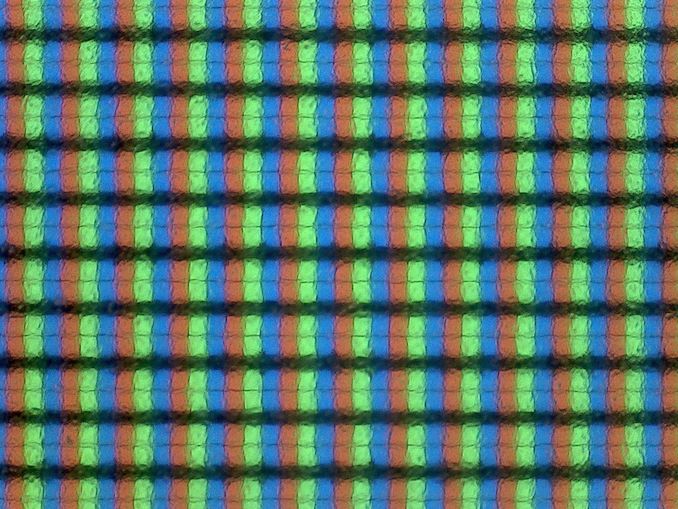 Acer Nitro 5 Subpixels with Anti-Glare coating
Acer Nitro 5 Subpixels with Anti-Glare coating
At 15.6-inches in size, the 1920x1080 resolution does allow you to run 100% scaling without the elements getting too small. That’s a benefit for sure, since you won’t get the artifacts that can still existing when using scaling in Windows 10. There’s been a lot of improvements to the OS to correct this, but not all applications have taken the time to ever deal with it. Luckily that won’t be a concern at 100%.
To test the display we use SpectraCal’s CalMAN suite with a custom workflow. Brightness and contrast readings are taken with the X-Rite i1Display Pro colorimeter, and color readings are taken with the X-Rite i1Pro2 spectrophotometer.
Brightness and Contrast
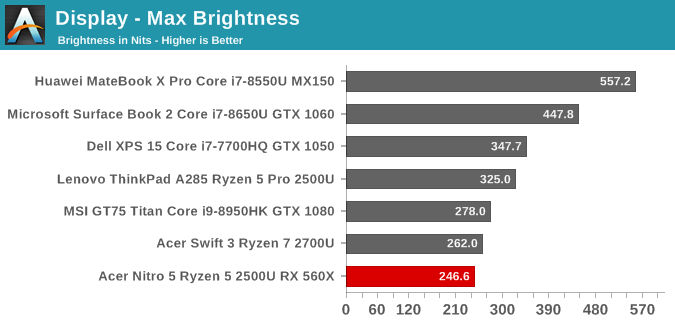
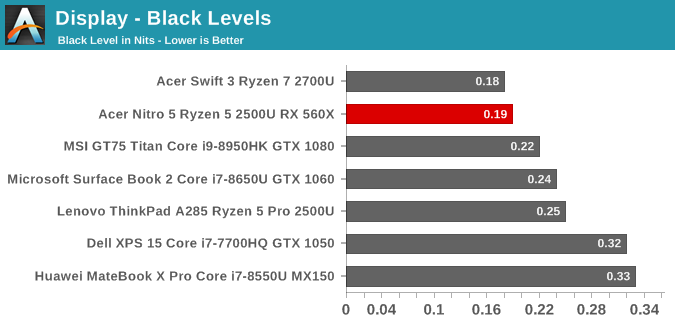
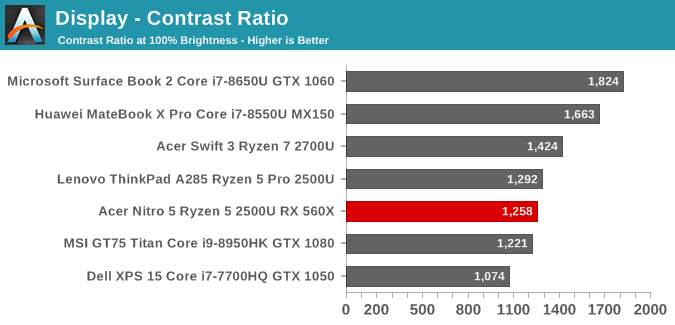
The panel on the Nitro 5 doesn’t get particularly bright, topping out at just 246 nits. It also doesn’t get particularly dark either, with a minimum brightness of 16 nits. But both values are likely fine for use indoors on a desk. The black levels are quite good though, leading to a solid contrast ratio of 1258:1 at maximum brightness.
Grayscale
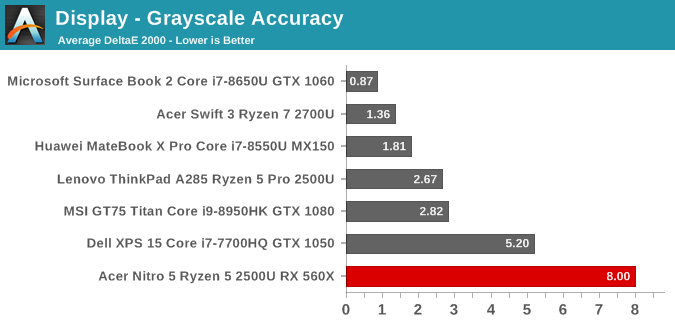
Here is where things start to get unravelled for the Nitro 5. The grayscale accuracy is terrible, thanks to the green part of the backlight being far too bright at almost any point in the range. The gamma curve is also well off the 2.2 value expected, falling increasingly under that point starting at around 35% brightness. This means there will be less of a dynamic range between highs and lows as you go towards greater brightness levels.
Gamut
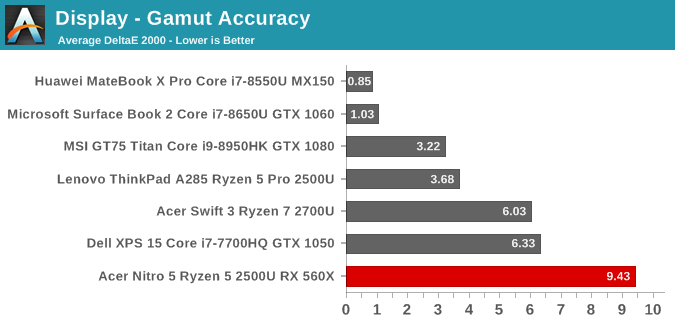
Here we can start to see the problems inherent in this display. The greens are the only colors even close to hitting the sRGB gamut, with red well under and blue doing its best impression of Hawaii. The graph ranges had to be adjusted just to see on the chart how far blue is off the mark, and at almost a dE2000 of 25, it is very, very far from where it should be.
Saturation
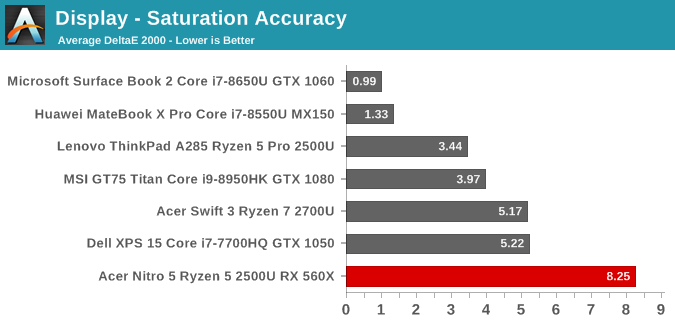
Gamut is the primary and secondary colors at 100% brightness, whereas with the saturation sweep we test with 4-bit steps from 0% to 100%. It’s amazing just how far off the blue levels are, and coupled with the less than amazing reds, the magenta values are also dramatically impacted.
Gretag Macbeth
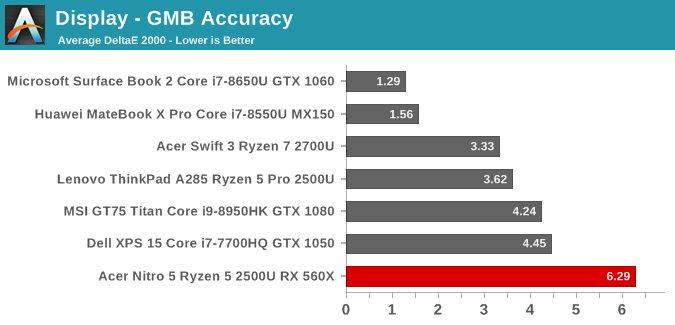
This graph also needed to have almost all of the charts adjusted to show just how far off the mark the colors are on this display. Considering the less than amazing primary colors, it’s no shock that every single color is pretty much terrible.
Colorchecker
This image shows the intended color on the bottom, and the achieved color on the top, so it gives a nice representation of the previous tests. The whites are very green, and the colors are mostly terrible.
Display Conclusion
This display is possibly the least accurate IPS panel we have ever tested. The uncalibrated panel is coupled with a backlight that can’t even come close to covering the entire sRGB spectrum. The Acer Nitro 5 is an entry-level device, and the display is one of the ways they made it to their target price.















90 Comments
View All Comments
Peter2k - Friday, February 15, 2019 - link
Would be interestingI've ordered a FX505DY, from Asus, and it has the same GPU, an "upgraded" 3550H but also just one RAM stick
And rule of thumb with Ryzen is single channel = terrible performance
So it would be interesting to see how it impacts performance here
Also I wonder personally if in my case Asus would let me at least RAM XMP settings instead of running it stock at 2400 no matter what
Annnonymmous - Friday, February 15, 2019 - link
Sorry to disappoint, but my results were very similar in dual-channel. I know that if used for the onboard GPU, the results would definitely be better, but for the discrete card, there's no appreciable difference in the results.Peter2k - Saturday, February 16, 2019 - link
Thx anywayCheers
Annnonymmous - Friday, February 15, 2019 - link
Here is my results: https://www.3dmark.com/fs/18345476deksman2 - Saturday, February 16, 2019 - link
You might experience slightly higher CPU performance though... and also, synthetic benchmarks aren't too representative of real-world performance.I suggest you try running actual games with dual-channel for more accurate comparison.
Still, when it comes to the article, I don't necessarily agree that its AMD fault for low battery life... but mainly that Acer paired it with a very low capacity batter instead. It IS a 25W TDP APU part after all, and the IGP should be handling most of the media watching.
Brett Howse - Saturday, February 16, 2019 - link
Raven Ridge has a power usage issue at idle. All Raven Ridge laptops suffer from poor battery life unfortunately.LarsBars - Sunday, February 17, 2019 - link
I thought I have read all the AT articles about Raven Ridge. What exactly is the issue? Can you link me to the explanation, thanks.Brett Howse - Sunday, February 17, 2019 - link
https://www.anandtech.com/show/13726/the-lenovo-th...Annnonymmous - Sunday, February 17, 2019 - link
The battery life is just fine. I regularly bring this thing to my bedroom and use it to complete work before bed. It runs dead silent and only warm to the touch. While I have a lapdesk, it is unneeded because the bottom ventilation is great. Your knee/leg won't possibly cover up all holes. Further, 3-4 hours is plenty.On older games, you'll get 3 hours off the APU too. So something to consider.
PeachNCream - Friday, February 15, 2019 - link
Accurate screens are nice, but I think there's a bit of an over-emphasis placed on that sort of thing here mainly because, in the past, other review sites didn't actually do detailed color analysis and instead just tossed out a quick statement based on eyeball observations. It sort of resulted in that analysis becoming a differentiator between AT and the competition so the focus on it when, for most people, it really doesn't matter, is a leftover. That doesn't mean its a useless thing, of course. I'm sure there are people that care (or at least will think they should care because they have devised some reason to believe it matters a lot) so it should continue and readers can filter for spam as needed with liberal use of the page selector.